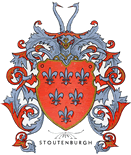
DESCRIPTION:
Arms: Do gules a six fleurs-de-lis argent
Crest: Deur totes et cols de grue accestees d’argent
Translation from French: Red shield bearing six fleur-de-lis of silver. For a crest, two cranes heads and necks, facing each other, silver and beaked red.
SYMBOLIC MEANING OF THE ABOVE INSIGNIA CITED FROM ARMORIAL SOURCES:
Red: The first color named in the exemplification of arms is always the principal color of the shield. Red in heraldry denotes martial fortitude and special magnanimity which was "noblesse oblige" in persons of high and gentle birth, whose deeds of valor were supposed by the code of chivalry to be accompanied by magnanimity toward the defeated adversary.
Silver: Stands for sincerity, hence fidelity and also for peace.
Fleur-de-lis: The ensign anciently used by the sovereigns of France to decorate not only their arms but also their robes, crown, and the royal standards of France. Charles V reduced the number on the royal shield to three. In gold on an azure ground, this remained the coat-of-arms of the royal family. Considered by many the most beautiful of all heraldic insignia, the fleur-de-lis has been depicted in no less than sixty-four variant forms. Some authorities regard this ensign as derived from the lily, others from the iris. It is found in the armorials of every country in the western hemisphere, having been brought to England, Scotland, and Ireland by the Norman conquest of William the Conqueror, and later it appeared in the arms of England’s royalty as long as the royal houses continued to lay claim to territory in France or to the French throne itself. It appears in the heraldry of continental nations through intermarriages with French families through conquest or even through simple predilection for this beautiful bearing by the original grantee of arms. The number of fleur-de-lis displayed on a family’s shield was often times determined by the need to differentiate from other families bearing this ensign.
Cranes facing each other form a decorative design very similar to the popular "horns" frequently found on continental heraldry. This is a possible reason for using two in place of one. The crane was often times a well-established resident on the lands and waterways of the original grantee of these arms and for this reason would have been a desired identification. Moreover, legend has it that the crane is so concerned for the safety of his young that he balances upon one leg holding a stone in the claws of the other, so that should he fall asleep, the stone, slipping from his grasp will awaken him. Hence the crane is a symbol of vigilance. As part is considered to stand for the whole, in heraldry, any part of this bird holds the meaning of the whole. According to John Guillim, pursuivant, in his Display of Heraldry, published 1624, "birds are a very worthy bearing in coat-armor, because they do more participate of air and fire (the two noblest and highest elements) than of water and earth as other creatures."
MOTTO: Nil scire tutissima fides.
TRANSLATION FROM LATIN: To know nothing is the safest faith.
The helmet and mantling are integral parts of "full achievements" in a representation of coat-armor. In British heraldry, even the position of the headpiece, the type of visor, and the use of steel, silver, or gold depicting the helmet are varied in a manner to indicate the degree or rank of the bearer. However, these rules are not generally observed in continental heraldry. The wreath immediately above the helmet, supporting the crest, represents twists of silken scarves always shown in the two colors of the mantling. The mantling is derived from the cloak or mantle worn to protect the bearer from cold, wind and rain. The swirls and drapes have become conventionalized into decorative patterns. As cuts in ones mantle indicated martial engagements, it was considered that the more cuts, the more gallantry and courage on the part of the bearer of the arms. Hence the many incisions in the draping of the mantling as it descends over the sides of the shield. The arms were often embroidered on the mantling and shown also in the rich coverings of the mount, thus identifying the rider from every angle. The arms of John Van Olden Barnevelt, which are also known, do not agree in any detail with the Van Stoutenburg arms. However, as the history of the Van Olden Barnevelt’s family is both gallant and tragic there may have been a reason for one branch or another to change the armorial ensigns with the change in name.

